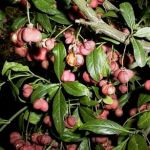| Common Name: |
Spindle Tree |
| Botanical Name: |
Euonymus europaeus |
| Genus: |
Euonymus |
| Family: |
Celastraceae |
| Cultivation: |
Well-drained soil in sun or partial shade. Thin out shoots in late winter to maintain shape. Euonymus europaeus is prone to scale insects and aphids. |
| Propagation: |
By seed sown when ripe; by greenwood cuttings in summer. Seed needs stratifying and is viable for 2 years. |
| Harvest: |
Bark is collected in autumn and dried for use in decoctions, tablets, and tinctures. |
| Native Location: |
Central and Eastern N America |
| Height: |
2-8m (6-25ft) |
| Width: |
1.2-3m (4-10ft) |
| Variations: |
Red Cascade
Has richer autumn color and a heavier crop of rose-pink fruits.
Height: 3m (10ft)
Width: 2.5m (8ft) |
| Hardiness: |
Z3-8 |
| Parts Used: |
Bark, root bark |
| Properties: |
A bitter, astringent herb that acts as a diuretic and emetic, and stimulates bile flow. |
| Medicinal Uses: |
Internally for liver and gall bladder complaints. Externally for chilblains, abscesses, acne, and wounds. |
| Warning: |
All parts, especially fruits and seeds, are harmful if eaten. |
| Bibliography: |
Encyclopedia of Herbs by Deni Brown. Copyright © 1995, 2001 Dorling Kindersley Limited. pg 208
|
